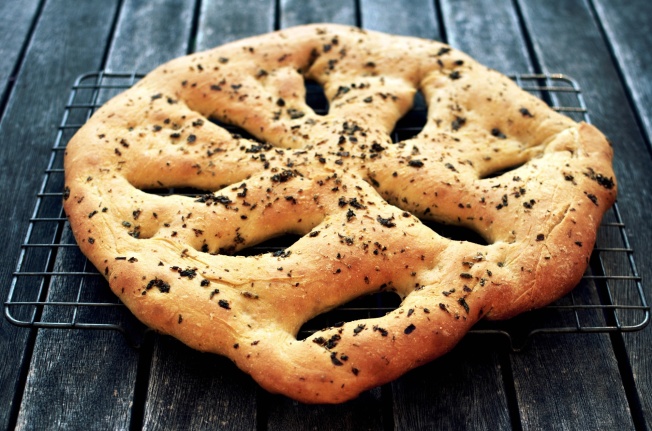
So it was my last day at work on Wednesday and as is customary whenever something moderately eventful takes place (birthday, being late, being early, being alive…) it is expected you bring in something edible. Almost always the food tends towards the sweet and absolutely always, unless I’ve had anything to do with it, is shop-bought. But not today, ohhh no!
The recipe for the dough for these delightful savoury snacks is stolen completely from Brendan of The Great British Bake-Off Fame. The fillings, however are entirely my own creation.
I doubled Brendan’s quantity and made a lot (we’re talking tipping the scales at over 100 here) roughly 2 inch diameter by 1 inch high swirls. So I’m going to halve his recipe which should give you approximately 20-24 swirls.
Ingredients
Dough
400g plain flour
10g dried yeast, reactivated
6g salt
50ml olive oil
250ml warm water
Balsamic Red Onion, Cheese & Ham
2 red onions, diced
90g gruyére
30g gouda
30g cheddar
2 slices ham, diced
splash balsamic vinegar
pinch of sugar
salt/pepper/’erbs/spices to taste
Pesto, Feta & Sundried Tomato
100g feta, crumbled
50g pesto
8 sundried tomato, chopped
handful fresh basil, ripped
2 tomatoes, grilled & skinned
1 red pepper, grilled & skinned
Method
Dough
In a bowl mix the flour and salt and the oil a few glugs at a time, stirring between each glug to incorporate it. Do the same with the reactivated yeast, stirring in a little at a time and then finally with the water.
**Note: if you are reactivating yeast in water, remember to take away that quantity of water from the 250ml you need to add. It’s 250ml total, not 250ml + reactivated yeast water!**
Drizzle a little oil in the bowl, place the dough in, rolling it around in the oil so as it grows it doesn’t stick to the sides. Put in a warm place – airing cupboards are great – and leave to double in size (approx. 40-60 minutes). Meanwhile make your filling/s.
Balsamic Red Onion, Cheese & Ham
Heat a dash of oil in a frying pan over a medium heat. Add the diced onions and sweat for a couple of minutes, before adding a good glug balsamic vinegar and a sprinkling of sugar/golden syrup, salt, pepper and whichever herbs and spices you fancy (I went for W’s recommendation of rosemary and basil). Continue to sweat for 6-7 more minutes, adding a little water if your pan goes dry. Remember the onions will continue to cook in the oven so leaving them with a little bite left in them is probably a wise move!
Grate all your cheese into a bowl, add the chopped ham, a good few twists of pepper and hey presto your filling is ready
Pesto, Feta & Sundried Tomato
Optional: Removing Pepper & Tomato skins
Cut the pepper and tomatoes into quarters, removing all the pips/liquidy innards. Place under a hot grill, skin side up for a few minutes, until the skin is blackened over the majority of the surface – you may need to manoeuvre them around to achieve this. Once the skin is blackened add them to a sandwich bag, seal and leave to steam for a further few minutes. The skin should start to peel away and you can finish the job with your fingers. It can be a bit tricky and in all honesty I’m not sure whether it’s worth it but I’ve put it up here for you to make your own decisions! Finally chop/rip them up into small chunks.
Crumble the feta into a bowl and add the chopped sundried tomatoes and basil leaves.
Roly-Poly Time
When the dough has doubled in size, remove and place on a floured surface. Flour your rolling pin (it will stick due to the oily nature of the dough) and roll out into a rectangle approx 4mm thick, where the long side is approximately twice that of the short side. Then either:
1. Sprinkle the entire thing with the balsamic red onions, then cheese and ham – aim for a roughly even coverage.
Or
2. Spread a thin layer of pesto over the surface before adding the crumbled feta, sundried tomatoes, basil, and grilled peppers/tomato chunks
Roll up (roll up!) from one long side to the other, slice into rounds 1 inch thick and place on baking paper on an oven tray. Here you can “re-prove” your dough for half an hour back in the warm, or you can just whack them straight in the oven, preheated to 190oC/375oF/gas mark 5 for approximately 30-40 minutes, or until golden brown. After half an hour take one out, cut it in half and see whether it’s still doughy inside – if so stick back in for a few minutes then check again.
Serve piping hot – they taste pretty good cold but nowhere near as good as straight from the oven. Share amongst friends and work colleagues…or, y’know, scoff the lot y’self.
J(&W a bit)

Balsamic Red Onion, Cheese & Ham

Feta, Pesto, Sundried Tomato & Red Pepper








